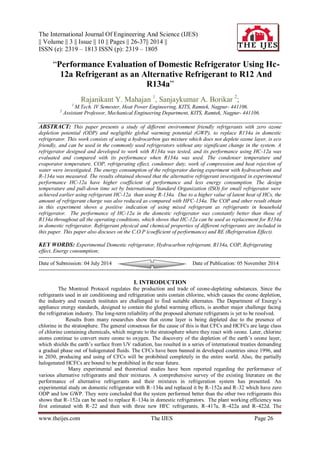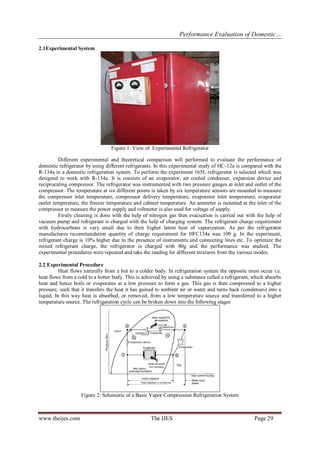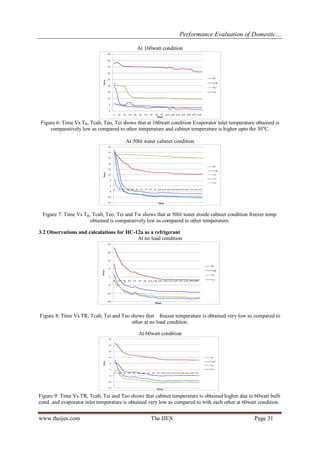This document summarizes an experimental study that evaluated the performance of HC-12a (a hydrocarbon refrigerant mixture) as an alternative to R134a in a domestic refrigerator. The refrigerator's performance was tested using each refrigerant and results for temperature, coefficient of performance (COP), energy consumption, and other metrics were compared. Testing showed HC-12a had a higher COP, less energy consumption, and achieved temperature targets faster than R134a. Overall the study found HC-12a performed better than R134a and could be used as a replacement without system modifications.










![Performance Evaluation of Domestic…
www.theijes.com The IJES Page 36
Figure 24: Time Vs COP of no load, 60watt, 120watt, 160watt, 50lit cabinet and 2lit freezer water condition shows that all cops at different conditions are comparatively higher at starting periods and all different type of cop occurs in the range of 6.96 to 2.97. IV. CONCLUSION As per the Kyoto and Montreal protocols, the harmful refrigerants are to be phased out and are to be replaced with alternate environmental friendly refrigerants with zero ozone depletion potential (ODP) and negligible global warming potential (GWP), to replace R-12 and R134a in domestic refrigerator 1. Hydrocarbons blends may replace R-134a without any system modifications. 2. COP of the system is improved with reduced energy consumption. 3. Hydrocarbon refrigerants are compatible with mineral oils (commonly used lubricants). 4. Hydrocarbon technology provides a simple, sustainable and cost-effective solution for replacing R-134a in the domestic refrigeration subsector in developing countries. 5. Chemical and thermodynamics properties of hydrocarbon meet the requirement of a good refrigerant. 6. Some standards allow the use HCs as refrigerant if small amount of refrigerant is used due the latent heat of vaporization. 7. The only disadvantage associated with this gas is its flammability, which can be an obstacle in its implementation. This problem can be solved by proper design of the refrigerator.. V. FUTURE SCOPE Hydrocarbons blends may replace R-134a without any system modifications and COP of the system is improved with reduced energy consumption. So our future intension is that increase the requirement of HC-12a as a refrigerant in all types of domestic refrigerators and air conditioning system in near future. Due to the zero ozone depletion potential (ODP) and negligible global warming potential (GWP), environments becomes a safe and sweets. In develop countries HC-12a as a refrigerant use in car air conditioning as well as industrial air conditioning. REFERENCES
[1]. Sahu R., December-2011, “Comparative analysis of mint gas with R-12 and R-134 refrigerants.” International Journal of Scientific & Engineering Research, Volume 2, Issue 12, ISSN 2229-5518, Pp:1-4
[2]. Tiwari A., Gupta R.C., 2011,“Experimental study of R-404A and R-134A in Domestic Refrigerator.” International Journal of Engineering Science and Technology (IJEST), Pp:6390-6393.
[3]. Austin N., Dr. SenthilKumar P., Dr. Diaz P. M., April 2013, “Experimental Study of HC Mixtures to Replace R-134a in a Domestic Refrigerator with Testing and Training of ANN.” Indian Journal of Applied Research. Volume : 3 | Issue : 4 | ISSN - 2249-555X,pp:163-167.
[4]. Rocca V. L., Panno G., 2011 ”Experimental performance evaluation of a vapour compression refrigerating plant when replacing R22 with alternative refrigerants.” Applied Energy 88,pp: 2809–2815.
[5]. Bolaji B. O., 2010,“Experimental study of R152a and R32 to replace R134a in a domestic refrigerator,” Energy 35, pp:3793– 3798.
[6]. Jwo C. S., Ting C. C., Wang W. R., 2009 “Efficiency analysis of home refrigerators by replacing hydrocarbon refrigerants,” Measurement 42, pp:697–701.
[7]. Bi S., GuoK., Liu Z., Wu J., 2011, “Performance of a domestic refrigerator using TiO2–R600a nano–refrigerant as working fluid,” Energy Conversion and Management 52, pp:733–737.
[8]. Quraishi M. A., Wankhede U. S., Jan-Feb. 2013, “Use of Hydrocarbons and Other Blends as Refrigerant.” International Journal of Modern Engineering Research (IJMER) Vol.3, Issue.1, pp-250-253,ISSN: 2249-6645.
[9]. Aprea C., Maiorino A., Mastrullo R., 2011 “Change in energy performance as a result of a R–422d retrofit: An experimental analysis for a vapor compression refrigeration plant for a walk in cooler,” Applied Energy 88, p:4742–4748.
[10]. Llopis R., Cabello R., SánchezD., Torella E., Patino J., Sánchez J. G., 2011, “Experimental evaluation of HCFC–22 replacement by the drop-in fluids HFC-422a and HFC-417b for low temperature refrigeration applications,” Applied Thermal Engineering 31 pp: 1323–1331.](https://image.slidesharecdn.com/e03102026037-141125040157-conversion-gate02/85/Performance-Evaluation-of-Domestic-Refrigerator-Using-Hc-12a-Refrigerant-as-an-Alternative-Refrigerant-to-R12-And-R134a-11-320.jpg)
![Performance Evaluation of Domestic…
www.theijes.com The IJES Page 37
[11]. Khorshid E., Alshiraan B., Alsairafi A., Alzemi A., Allahddad A., 2011, “Performance investigation on new refrigerant mixture”pp15-20.
[12]. Rasti M., Hatamipour M.S., Aghmiri S.F., Tavakoli M., 2012, “Enhancement of domestic refrigerator’s energy efficiency index using a hydrocarbon mixture refrigerant,” Measurement 45 pp:1807–1813.
[13]. Sattar M. A., Saidur R., Masjuki H. H., 2007 “Performance investigation of domestic refrigerator using pure hydrocarbons and blends of hydrocarbons as refrigerants,” World Academy of Science, Engineering and Technology 29 pp:223–228.
[14]. Saidur R., Kazi S.N., Hossain M.S., Rahman M.M., Mohammed H.A., 2011, “A review on the performance of nano particles suspended with refrigerants and lubricating oils in refrigeration systems,” Renewable and Sustainable Energy Reviews 15,pp: 310–323.
[15]. Corberan J. M., Segurado J., Colbourne D., Gonzalvez J., 2008, “Review of standards for the use of hydrocarbon refrigerants in A/C, heat pump and refrigeration equipment,” International Journal of Refrigeration 31, pp: 748–756.
[16]. Cengel Y. A., Bole M. A., Thermodynamics, An Engineering Approach 7e. pp:610-611.
[17]. Chen S., Judge J. F., Groll E. A., Radermacher R., 1994, “Theoretical Analysis of Hydrocarbon Refrigerant Mixtures as a Replacement for HCFC -22 for Residential Uses”, International Refrigeration and Air Conditioning Conference, pp: 225-230.
[18]. Kim M. H., Lim B. H., Chu E. S., 8 Oct 1998, “The Performance Analysis of a Hydrocarbon Refrigerant R-600a in a Household Refrigerator/Freezer”, KSME International Journal, Vol. 12, No. 4, pp. 753~ 760.
[19]. Liu Z., Haider I., Liu B. Y., Radermacher R., 1994, “Test Results of Hydrocarbon Mixtures in Domestic Refrigerator/Freezers”, Center for Environmental Energy Engineering (CEEE) University of Maryland College Park, Maryland, USA, PP: 22-31.
[20]. Maclaine-cross I. L., Leonardi E., June 1997, “Why Hydrocarbons Save Energy”, School of Mechanical and Manufacturing Engineering The University of New South Wales Sydney NSW, Australia 2052, Published in AIRAH Journal, Volume 51 No. 6, pp. 33–37.
[21]. Baskaran A., Mathews P. K., September 2012, “A Performance Comparison of Vapour Compression Refrigeration System Using Eco Friendly Refrigerants of Low Global Warming Potential”, International Journal of Scientific and Research Publications, Volume 2, Issue 9, ISSN 2250-3153, pp: 1-8.
[22]. Almeida I. M. G., Barbosa C. R. F., Fontes F. A. O., December 2010, “THERMODYNAMIC AND THERMOPHYSICAL ASSESSMENT OF HYDROCARBONS APPLICATION IN HOUSEHOULD REFRIGERATOR”, Engenharia Térmica (Thermal Engineering), Vol. 9, N o 01 e 02, pp. 19-27,
[23]. Meyersen K., 1996, “HC REFRIGERANT PRODUCTS TRAINING MANUAL”, Northcutt, Inc 5055 N. Broadway, PP: 1-50.
[24]. Wongwises S., Chimres N., 2005, “ Experimental study of hydrocarbon mixtures to replace HFC-134a in a domestic refrigerator” Energy Conversion and Management 46, PP: 85–100.
[25]. Khurmi R. S., Gupta J. K., “Refrigration and Air Conditioning” publish by S. Chand, Revised Edition.](https://image.slidesharecdn.com/e03102026037-141125040157-conversion-gate02/85/Performance-Evaluation-of-Domestic-Refrigerator-Using-Hc-12a-Refrigerant-as-an-Alternative-Refrigerant-to-R12-And-R134a-12-320.jpg)